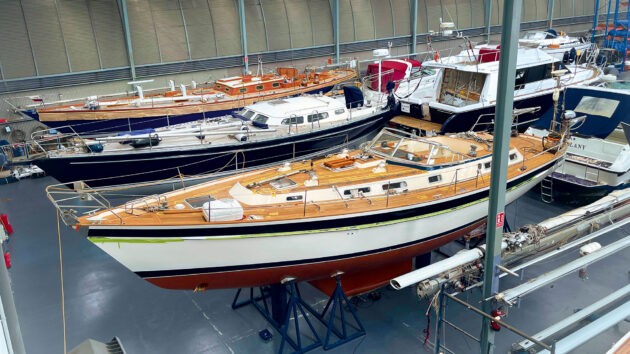Can you really ‘futureproof’ a yacht? Refit decisions made today could shape not just your next season, but the next decade, or more, on board says Will Bruton
Time in a boatyard rarely goes exactly to plan. Investigate beyond where you usually look and you’ll almost always uncover work that wasn’t expected. The trick is to turn that disruption into long-term value — tackling hidden jobs head-on and using time out of the water as an investment.
The old rule of thumb still applies: buy well but only buy once. With a clear game plan and good guidance futureproofing can be one of the smartest refit strategies there is.
Old, but far from out
To futureproof thoroughly, you need a good sounding board of expertise, like David Gabriel, the refit manager for Rustler Yachts. The traditional brand is perhaps still most closely associated with its 36; a classic, long-keeled cruising yacht that counts Princess Anne as a former owner.
HRH now sails a much more modern Rustler 44, but refits of the 36 remain regular work for Gabriel. He explains what updating an older yacht for the long haul can look like.
“The 36 refit we’ve got underway at the moment is designed to give her maybe a couple of decades before she needs another major overhaul. It’s very much an investment for the owner setting her up for a long sailing future. She’ll be a much more modern yacht in terms of technology than anyone could have imagined when she was launched.
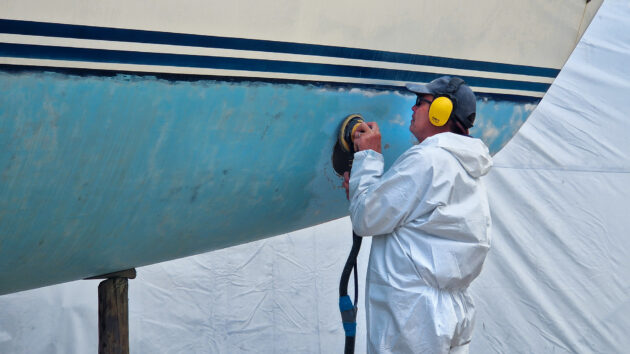
Spending money below the waterline might not often be seen, but is one of the first steps to futureproofing your yacht. Photo: Rustler Yachts
Forward-looking sonar, a hot water-based heating system instead of hot air, and completely new plumbing and electrics will make her feel new again,” explains Gabriel.
Surprisingly the original rig of the 1990s yacht was judged so good that it’s been given a clean bill of health — not in need of replacement for up to a decade.
So what makes an older design worth this level of commitment over a cheaper new production build? “It’s a pattern we’re seeing, including with other quality brands we refit,” says Gabriel. “It lowers the price threshold to own a really solid yacht at a time when raw material costs are pushing new prices up for everyone. While it’s not the same as commissioning a new Rustler, it’s a great way to enjoy a genuinely high-quality yacht.”
Jobs easily missed
Nathan Bone Yachts has been refitting yachts in Plymouth for over 50 years, seeing trends come and go, but also how getting the fundamentals right can set a yacht up for a long life with only routine maintenance needed. “Good futureproofing is about dealing with the jobs that are hard to reach, always with safety first in mind,” Bone says.
But which jobs to tackle, and in what order? “Ideally, we shape the work by talking a lot to the owner, building a solid relationship before we even start, and making a plan that will serve them well for years.
Like a classic car, even if the yacht isn’t that old, you always find more once you open her up. We’ll usually take a proper look at the keel, for example. It might be tempting to focus on the looks first, but the question should always be ‘What’s caused it to look like that?’ Often there’s something deeper going on.
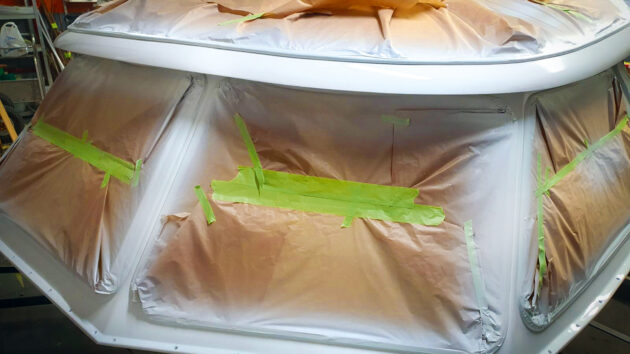
Coachroof refurbishment and repainting. Photo: Rustler Yachts
“The deck is always a big consideration. We restore teak wood when we can and enjoy doing it, but we also replace decks completely with teak or modern alternatives. That’s a major job – and one people often kid themselves about, thinking the deck has more life in it than it really does. If you can see the screws, it’s usually past it.
Good teak is wonderful, of course, but synthetic options can be excellent too — it depends on the yacht and the owner,” Bone explains.
So are things ‘not like they used to be’, or do improvements in terms of materials and fittings mean they last longer? “It’s a mix. Acrylic hull paints have improved massively and last a long time. Coppercoat, if applied correctly, can last 12 years. PropSpeed is a fantastic product that improves economy and speed and just wasn’t available before,” says Bone.
“We’d also always recommend spending on quality deck gear — that’s an area where the metal quality from some makers has definitely dropped.”
Article continues below…
A second hand yacht that holds its value? Here’s how to get one
Whisper it quietly, but yachts, and perhaps their owners too, quite often have an archetype. A well-worn Amel Super Maramu…
What’s hidden beneath
Neil Desty of Desty Marine is well known in the UK yachting industry as a go-to yard by marine insurance companies, as well as for contracts with major UK yachtbuilders. He suggests that everything under the waterline is the first thing to consider when looking to futureproof. “Spending money on what you don’t see in the water isn’t often so appealing to an owner but it’s absolutely fundamental.
“Spending money here is generally spending money you won’t spend again for a long time, so, if you change a seacock, consider changing all of them, and, why would you change a seacock and not change the hose coming off of it? It just makes sense.”
When it comes to the hull itself, Desty notes there is often reluctance to spend there too. “If we’re taking the keel off, spend a little extra for some good quality washers, a good quality plate, and generally do things properly. We do a lot of osmosis treatment and owners are often tempted to save a bit by not putting in a good layer of epoxy to give it a good waterproof layer and seal off the laminate.”
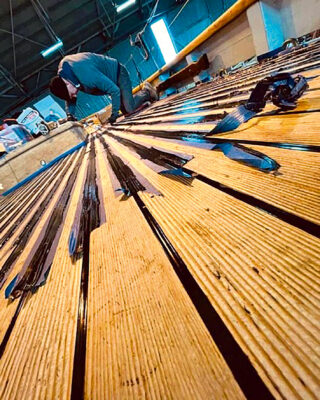
Watertight decks are vital, whether real wood or synthetic alternatives. Photo: Rustler Yachts
Good ingredients
In an age where the yachting industry has become increasingly environmentally conscious, buying well-made yacht components might be one of the best things we can do to minimise impact on the environment, simply by making things last longer.
When it comes to deck fittings, poor quality metal has found its way onto many yachts over the past decade, often the result of cheaper raw materials from China and rising prices closer to home.
Some marine manufacturers are making a point of buying the best quality they can, explaining to customers why their product costs more instead of trying to compete on price. Alex Blair, UK sales manager for Ultra Anchors, explains: “We only occasionally get objections to our anchors, and it’s always about price. But once we explain, it makes sense.
We use Swedish 316 steel for Ultra anchors — it’s the best you can buy — and that lets us offer a genuine lifetime warranty on the anchor and five years on the swivels.
“Stainless steel chain costs more than galvanised, but for good reason, so we’ve taken the same approach there too. Long-term sailors know their anchor is their insurance policy, and it’s something you absolutely have to get right.”
Anything on deck will be exposed to UV. Plastic fittings are particularly vulnerable, and those made with UV-stabilised materials will last much longer. Investing in proper covers can also dramatically extend the life of deck components.

Hull and keel integrity is fundamental to a yacht’s long term future. Photo: Will Bruton
Buying Smarter for Longer
Some yacht kit has a surprisingly short shelf life, while other gear — if you choose carefully — can be fitted once and forgotten about for decades.
Batteries
Lead-acid or AGM types are usually good for three to five years before sulphation sets in, while a well-managed LiFePO₄ lithium bank will still be cycling happily after 10-15 years.
Standing rigging
Stainless steel wire is typically changed on a 7-10 year schedule, often at an insurer’s insistence. Modern Dyneema (the creep-resistant DM20 variety) can run for a decade or more if it’s properly jacketed and protected from UV.
Sails
Plain Dacron will last 7-10 years of moderate seasonal use, but a Hydranet or Dyneema-reinforced cloth can add several seasons – sometimes 12-15 years – before shape loss forces a replacement.
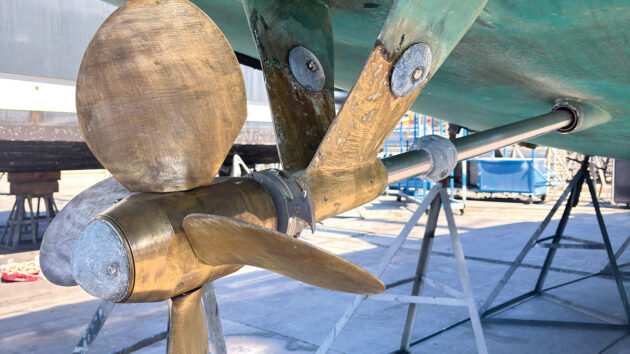
When a boat is out of the water there’s no point in not checking and replacing sacrificial anodes. Photo: Will Bruton
Anchor chain
Galvanised anchor chain typically needs replacement after 5-10 years of hard service, but stainless steel chain can often last more than 20.
Seacocks
Brass seacocks may dezincify in as little as five years, while bronze or Marelon valves often see out the life of the boat.
Hardware
Deck hardware follows the same pattern. Cheap plastic-sheaved blocks will wear and seize quickly, whereas a bronze or stainless winch, kept greased and maintained, is an investment.
Electronics
Magnetron radars are prone to fade after 5-7 years, whereas solid-state Doppler sets don’t have these issues.
 If you enjoyed this….
If you enjoyed this….
Yachting World is the world’s leading magazine for bluewater cruisers and offshore sailors. Every month we have inspirational adventures and practical features to help you realise your sailing dreams.Build your knowledge with a subscription delivered to your door. See our latest offers and save at least 30% off the cover price.
Note: We may earn a commission when you buy through links on our site, at no extra cost to you. This doesn’t affect our editorial independence.




